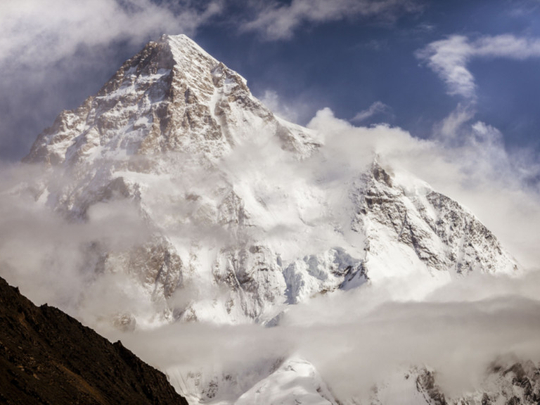
It’s not often that a team of climbers attempts K2, the “Savage Mountain,” in winter.
Before this season, the world’s second-highest mountain, first climbed in 1954, had been tried only six times in the coldest months. Each effort ended in failure. Even so, recently two expeditions of Nepali climbers converged on the Godwin Austen Glacier in a remote corner of Pakistan to attempt the feat.
Neither of the groups was there to guide Western clients to the top and then take back seats to their accomplishments, as Nepalis in general and ethnic Sherpa in particular often do as the hired help. They were climbing for themselves. Both teams made it together to the 28,251-foot summit in January, making a statement of teamwork and selflessness for Indigenous Himalayan climbers.
Scaling K2 in winter was perhaps the last great prize of high-altitude mountaineering, a sport born as an expression of national strength among Western European nations in the mid-20th century. In a remarkable golden age from 1950 to 1964, all 14 of the world’s mountains above 8,000 meters (26,247 feet) were climbed for the first time: The French got Annapurna and Makalu, for instance, the Italians K2, and the British Kanchenjunga. Yet every expedition relied on local labour as guides.
The Nepali mountaineering community has dealt with more than its fair share of hardship. The last few years have been no exception. In 2014, an avalanche killed 16 Sherpa on Everest, and then a 2015 earthquake decimated base camp, killing some 20 people, about half of them Sherpa, and prompting a general evacuation.
In 2020 the mountain was closed because of COVID-19 — meaning that Everest, the financial lifeblood of the Nepali guiding community, has been open for business only in four of the last seven years. There have also been emotional losses, as when the Austrian-Sherpa superstar David Lama died climbing in the Canadian Rockies in 2019.
Enter Nirmal Purja. Like Lama and Tenzing Norgay, who with Edmund Hillary was the first to reach the top of Everest in 1953, Purja is a bit of an outsider. He is not Sherpa but Magar, another of Nepal’s ethnic groups. Born near Dhaulagiri, the world’s seventh-highest mountain, he grew up in Nepal’s flatlands.
Going by the moniker Nimsdai, Purja is outspoken voice on social media, exuding the confidence of a mountaineering Muhammad Ali, and has rubbed some the wrong way. “I promise the hardest, the last and the greatest mountaineering feet #k2winter will belong to the Nepalese climbing community,” he wrote in an Instagram post leading up to the climb. “I will not leave the base camp until the mission is accomplished.”
The leader of the other Nepali team, Mingma Gyalje Sherpa, or Mingma G. as he’s known, is a quieter soul. His father had lost fingers to frostbite after tying the laces of his client’s boots on Everest. Mingma G. made a name for himself soloing a new route up a 21,932-foot peak he could see from the window of his home in the Rolwaling Valley of Nepal. He has stood on top of Everest five times and K2 twice.
While Purja managed to secure the lucrative backing of Red Bull for his K2 project, the GoFundMe campaign that Mingma G. posted on his Facebook page raised less than $8,000 of a $47,500 goal.
The Nepalis were not alone in attempting K2. Some 25 foreign mountaineers joined them in base camp. They spanned the spectrum of experience from professional alpinists to commercial clients paying a premium for Sherpa support. All wanted to be the first to reach the summit in winter.
When 10 mountaineers left Camp 4 on the Abruzzi Ridge in minus-70 degree Fahrenheit weather and pushed toward K2’s summit, every one of them was Nepali. The teams led by Purja and Mingma G. combined forces, and were reinforced by an additional Sherpa from another expedition. They climbed the last few feet together while singing the national anthem of Nepal.
Alan Arnette, a chronicler of Himalayan climbing who made it to the top of K2 in the summer of 2014, told me that past winter attempts failed because of “lack of teamwork, lack of leadership and lack of focus. And some bad luck when it comes to the weather.” The Nepalis, on the other hand, got lucky with the weather, avoided avalanches, worked together and, he added, “were determined to show the world that Nepali climbers were among the best.”
Says Purja: “We united to make the impossible possible together. Let’s talk about unselfishness and making the greatest feat in the name of everyone because everyone deserves the equal credit.”
So much for what had been that most privileged, egocentric and colonial of pursuits. Let’s cheer the summiteers.
Freddie Wilkinson is an alpine climber, mountain guide, and author - The New York Times




_resources1_16a31069e4e_small.jpg)







